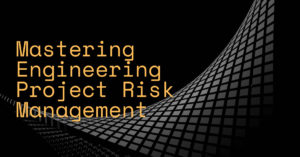
Engineering project management is the process of planning, coordinating, and controlling resources in an engineering project to meet specific goals. Risk management is a critical component of effective engineering project management.
Risk management is known as detecting, analyzing, and prioritizing risks to limit or eliminate their negative influence on the project.
In this blog post, we will explore the significance of risk management and risk identification in engineering project management and the numerous types of hazards that might arise during an engineering project.
Engineering Project Management Risk Types
Technical, financial, schedule, resource, quality and safety hazards are all possible in engineering project management:
- The probable failure of equipment or technology employed in the project is a technical risk.
- Budget and expense overruns are examples of financial hazards.
- Delays in the project timeframe are referred to as schedule hazards.
- The availability and allocation of resources, such as persons and supplies, are examples of resource hazards.
- The project’s possibility of failing to reach the needed standards is a quality risk.
- The possibility of accidents or injuries occurring during the project is a safety risk.
Identification and Evaluation of Risks
Identifying possible hazards and doing a risk assessment is the first step in successful risk management. This may be accomplished through brainstorming meetings, interviews with project stakeholders, and document review. Once discovered, prospective risks must be evaluated in terms of likelihood and effect. An either quantitative or qualitative examination can accomplish this.
Quantitative analysis is the use of numerical data to assess hazards.
Risk analysis based on personal information, such as expert views or prior experiences, is known as qualitative analysis.
Risks can be prioritized depending on their overall degree of risk after considering their likelihood and effect. This will allow the project team to prioritize the most critical threats.
Risk Reduction and Management
Once risks have been identified and analyzed, methods for mitigating or avoiding them must be developed and implemented. This might involve implementing a management strategy, introducing new technologies, or devoting more resources.
It is also critical to develop a risk management strategy that defines the activities to manage risks throughout the project.
Risks must also be monitored and controlled during the project to ensure they are appropriately handled. Regular meetings, progress updates, and other types of communication can help with this.
Techniques and Tools for Risk Management
There are several methods and strategies for managing risks in engineering project management. Among the most frequent are:
- SWOT analysis assesses the project’s strengths, weaknesses, opportunities, and threats.
- Failure Modes and Effects Analysis (FMEA) is a technique for identifying possible failure modes and their consequences.
- Monte Carlo simulation is used to assess the possibility of various project outcomes.
- Decision trees are used to assess the prospective outcomes of various options.
- A risk matrix is used to assess the likelihood and effect of hazards.
Project Manager Role
The project manager is essential in risk management since they direct the risk management process and engage with stakeholders. They are in charge of making decisions in difficult situations and managing stakeholder expectations and communication.
Risk Management Process for Engineering
Effective risk management is critical for engineering project success. Project teams may reduce the negative impact of risks on the project by recognizing, analyzing, and prioritizing risks and executing solutions to mitigate or prevent them. Project managers play a significant role in risk management because they must lead the risk management process and effectively communicate with all stakeholders.
A risk management strategy defining the activities that will be followed to control risks throughout the project is essential. Likewise, having a contingency plan in place may decrease chances by allowing the project team to respond swiftly and efficiently if a threat becomes a reality. Overall, risk management should be an ongoing process that evaluates and re-evaluates risks as the project advances.
Risk management is an essential component of engineering project management. Project teams may reduce the negative impact of risks on the project and raise the chances of success by recognizing, analyzing, and managing risks. All project team members must be involved for effective risk management, good communication, and a well-defined risk management plan. Engineering projects may be handled effectively and safely with the correct strategy and tools.

